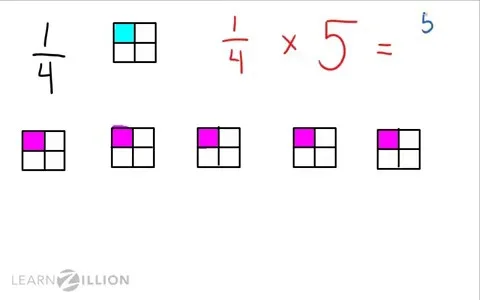
Additionally there are length area region and set models. Use the numerator to determine how many parts that need to be shaded in.

Multiply the fractions using an area model frac13 frac13 Solution.
Models for multiplying fractions. Area Models for Multiplication of Fractions PBS LearningMedia. Use area models to show a visual representation of the product of two fractions. This interactive exercise focuses on multiplying fractions and reducing them when possible.
This resource is part. Multiply the fractions using an area model frac13 frac13 Solution. In this problem we want to find frac13 of frac13 Step 2.
First we divide the height of a rectangle into 3 equal parts. We shade one part to represent frac13 Step 4. It is possible to use the set length or number line models for some situations involving multiplication or division of fractions.
However the most universal visual representation is the array. In particular it is best to use the area form of the array as shown on the right for the whole number example 4 by 6. Now comes the fun parthelping children understand multiplying fractions with models.
First draw a rectangle. Then look at the first fraction in the expression and divide the height of the rectangle by the denominator. Use the numerator to determine how many parts that need to be shaded in.
Multiplying Fractions Using Area Models Math with Mr. Multiplying Fractions Using Area Models Math with Mr. Multiplying Fractions Using Area Models.
Model each problem on the rectangles dividing and shading the regions based on the two fractions and count the overlapping parts to frame the product fraction in these fraction multiplication using area models worksheets. IXL Multiply two fractions using models 5th grade math. 3rd to 5th 6th to 8th.
Explore different representations for fractions including improper fractions mixed numbers decimals and percentages. Additionally there are length area region and set models. Adjust numerators and denominators to see how they alter the representations and models.
Multiplying and dividing fractions 5th grade Multiply a fraction by a fraction using visual representations An updated version of this instructional video is available. MODELS FOR FRACTIONS Linear Models One useful model for fractions is the liner model. In a linear model the whole or unit is represented by a specified interval on a number line.
Then fractions are represented as lengths of intervals in comparison to the length of the whole. This is a fluency worksheet to help students practice multiplying fractions by factions using models. It includes 6 equations that students must solve and a box for a model that students must create a shade.
It also includes 3 problems in which students must determine the equation and product by int. Lets think a little bit about what it means to multiply fractions say I want to multiply 12 times 14 well one way to think about this is we could view this as 12 of 14 and what do I mean there well let me take a whole let me take a whole here and let me divide it into fourths so let me divide it into fourths so Ill divide it into four equal sections and so 14 would be one of these four equal sections but we. Multiply fractions by whole numbers.
Youll gain access to interventions extensions task implementation guides and more for this instructional video. In this lesson you will learn how to multiply fractions by whole numbers by using visual models. This digital Google Slides activity for students to practice multiplying fractions with area models is perfect for distance or remote learning.
Students will move flip drag and drop fraction models to practice multiplying fractions with area models. This type of digital practice helps students to. In linear models of fractions the length of the whole is divided into equal lengths.
A fraction is identified as being a particular distance from the start of the whole. Dividing strips of paper into equal lengths is an example of using a linear model to represent fractions. Two or more of these strips placed side-by-side allows.
Multiplying Fractions Using Models. Let 4th grade and 5th grade learners first study the well-defined illustrations before answering the simple questions set here. Watch them enter into the spirit of multiplication of fractions and whole numbers using visual fraction models.
Multiplying fractions and whole numbers visually. Equivalent fraction and whole number multiplication problems. Multiply fractions and whole numbers.
Multiply fractions and whole numbers with fraction models. This is the currently selected item. Multiply fractions and whole numbers on the number line.
If playback doesnt begin shortly try restarting your device. Videos you watch may be added to the TVs watch history and influence TV recommendations.